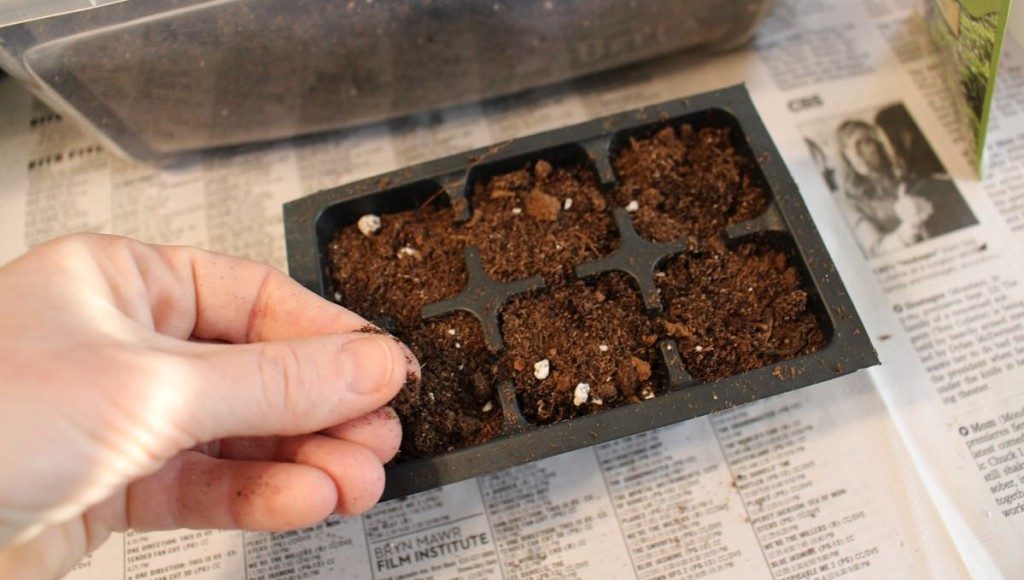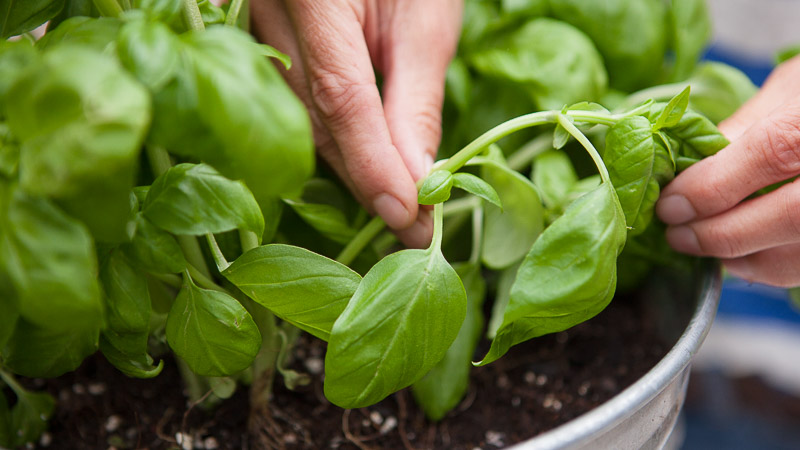Basil is an extremely fragrant versatile herb that you can grow indoors for different purposes including decoration, flavoring food and making fragrant oil. Growing basil indoors is not hard at all, in fact, it is one of the easiest herbs to grow indoors. There are many varieties of basil and all of them are fit for indoor gardening. If you want to learn how to grow basil indoors, just follow the below steps.
1. Step one: buy a good quality seeds

Basil seeds are widely available for fair prices. You can buy a packet of 100 seeds or more from your local nursery store for an extremely low price. However, basil seeds remain viable for years. Thus, you should buy the seeds from a reliable source to make sure that you get fresh seeds. Fresh seeds germinate faster and produce better.
2. Step two: Prepare the soil
Basil seeds require a good quality soil that is rich in nutrients and organic matter. A well draining potting soil would be perfect for growing basil indoors. It has a neutral ph level and it is consistently moist. For ph, it should be maintained between 6.0 and 7.5.
Once you choose a container for your basil seeds, fill it with soil. Then add water and mix the soil with water until it becomes moist. For best results, although you will get your hands dirty, you should mix the soil with your hands to ensure that it becomes evenly moist.
Any type of containers is suitable for growing basil indoors. Whether it is clay, plastic, stone, or concrete, as long as it has drainage holes, it is a perfect choice.
3. Step three: Planting
You should plant more than two seeds in each container in case some of the seeds fail to germinate. Sowing them is easy. All you need to do is to sprinkle them into the container without pressing them. If you are using a relatively small container, you should sow two to three seeds. However, for a larger container, you could plant up to 8 seeds. Don’t forget to leave an at least 1-inch gap between the seeds.
Once you scattered the seeds into the container, cover them lightly with soil. Avoid covering them with a thick layer of soil, a small soft layer is enough. As a matter of fact, the layer shouldn’t exceed 0.25 in thickness.
After planting your seeds, you should water them. Moisture is important for their growth and germination. Make sure that the top layer of soil is well moistened.
4. Step four: Choose a sunny spot for your container
Basil is one of the herbs that love sunlight exposure. In fact, sunlight exposure is crucial for the growth and the survival of basil. This lovely aromatic herb needs at least 6 hours of direct sunlight to grow and thrive. Therefore, it is recommended that you place your basil container on a sunny window.
However, if you don’t live in a warm place and you don’t have much access to direct sunlight, you should buy grow lights for your herb. fluorescent grow lights are known as the perfect replacement for sunlight. They will provide your plant with the necessary light it needs to grow.
When using artificial lights, you should allow your plant to receive at least 10 hours of light. It is important that you don’t place your plant too close to the artificial grow lights as they may burn it. It is recommended that you leave a distance of 2 inches between your plant and the grow lights.
Basil seeds usually germinate within 5 to 10 days. It largely depends on the amount of light they receive, the warmth and the moisture of the soil.
5. Step five: Watering
Basil requires moderate watering. This versatile plant likes neither drought nor overwatering. Therefore, water only when the top layer of the soil is dry when you touch it. Watering shouldn’t be done from above. You should avoid wetting the stem and leaves. Thus, water directly into the soil. In this way, you will allow the roots to absorb more soil and thus the plant will grow and thrive faster.
6. Step six: provide a good air circulation
Air circulation is important to keep the plant healthy and encourage its growth. Stagnation will stifle the growth of your plant. To provide basil with a good air circulation, you should consider placing a small fan close to your plant. Run the fan on the lowest setting for two hours daily. This will allow your plant to have the fresh air it needs.
7. Step seven: Pruning
Pruning is important for your plant to grow bushy and beautiful. Pruning basil is called pinching and it is better done often and early. The first pinching should be conducted when the plant reaches 8 inches in height and has at least 3 sets of leaves. Cut the above sets of leaves and leave the rest to grow. The cutting is suitable to use in your kitchen.
8. Step eight: Transplanting
You should transplant your plant only when it outgrows its container. Transplanting your basil into a larger container will help it reach its growth potential. Besides, it will keep your plant in a good health. If you want to avoid this step, you should choose a large container for your basil when you are about planting the seeds.
9. Step nine: Harvesting
You should start harvesting your basil before it flowers. Pinch off the flowers once you spot them. They will consume the energy of your plants. You could either pick off the leaves by hands or cut them off by a sharp knife or a scissor. If you want your plant to keep growing leaves, don’t pick up more than 1/3 of it.
It is recommended that you start picking the top leaves. You should always leave the bottom leaves to grow. Otherwise, it may prevent the growth of your plants’ stem and you will have to harvest the whole plant.
These are the best steps to learn how to grow basil indoors. If you follow these steps, you will grow this lovely herb indoors successfully. You shouldn’t hesitate to start growing this summer plant, it is easy to grow as well as it is easy to maintain. If you love herbs, you could also grow mint and parsley indoors.
Enjoy growing your basil and please lets us know if you need more tips.




